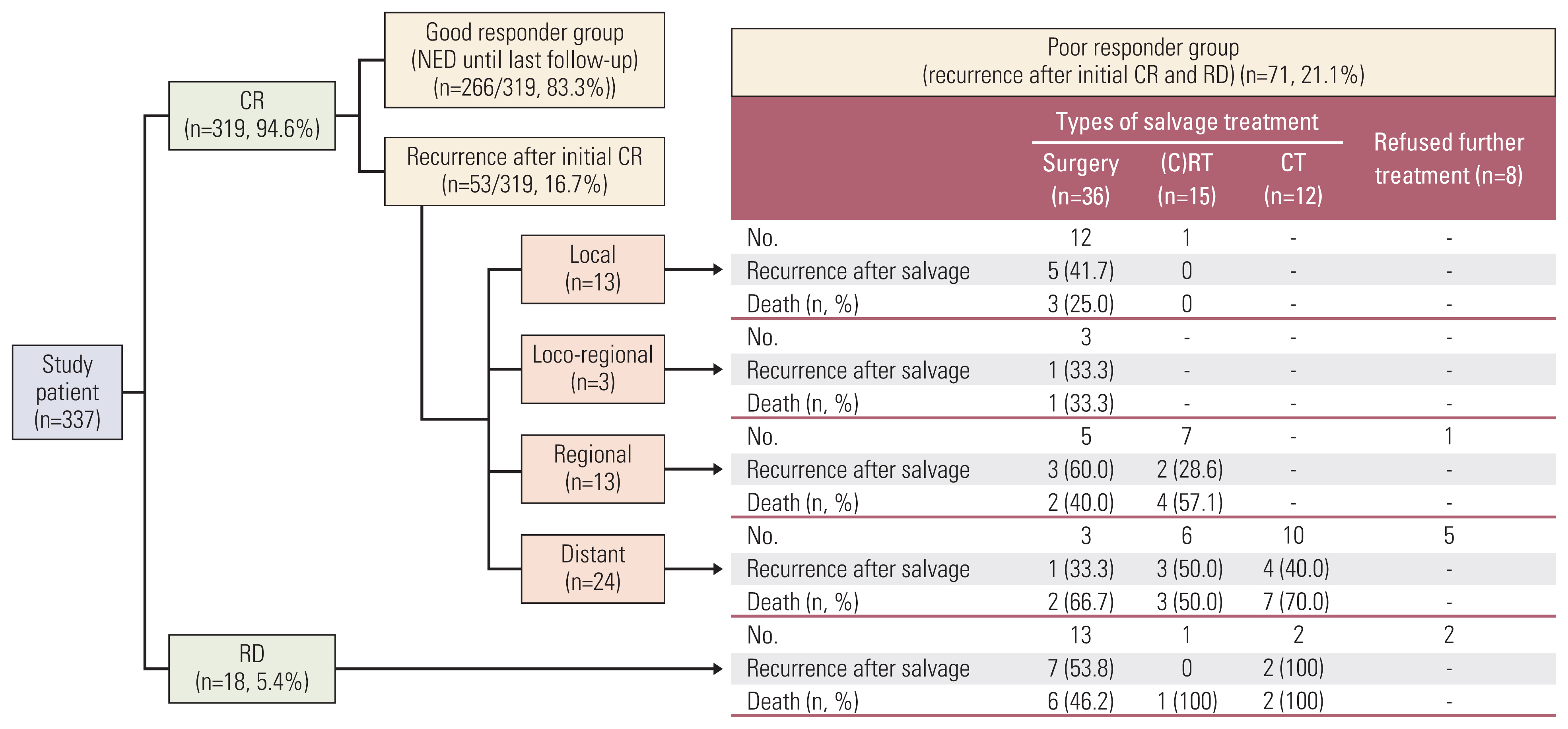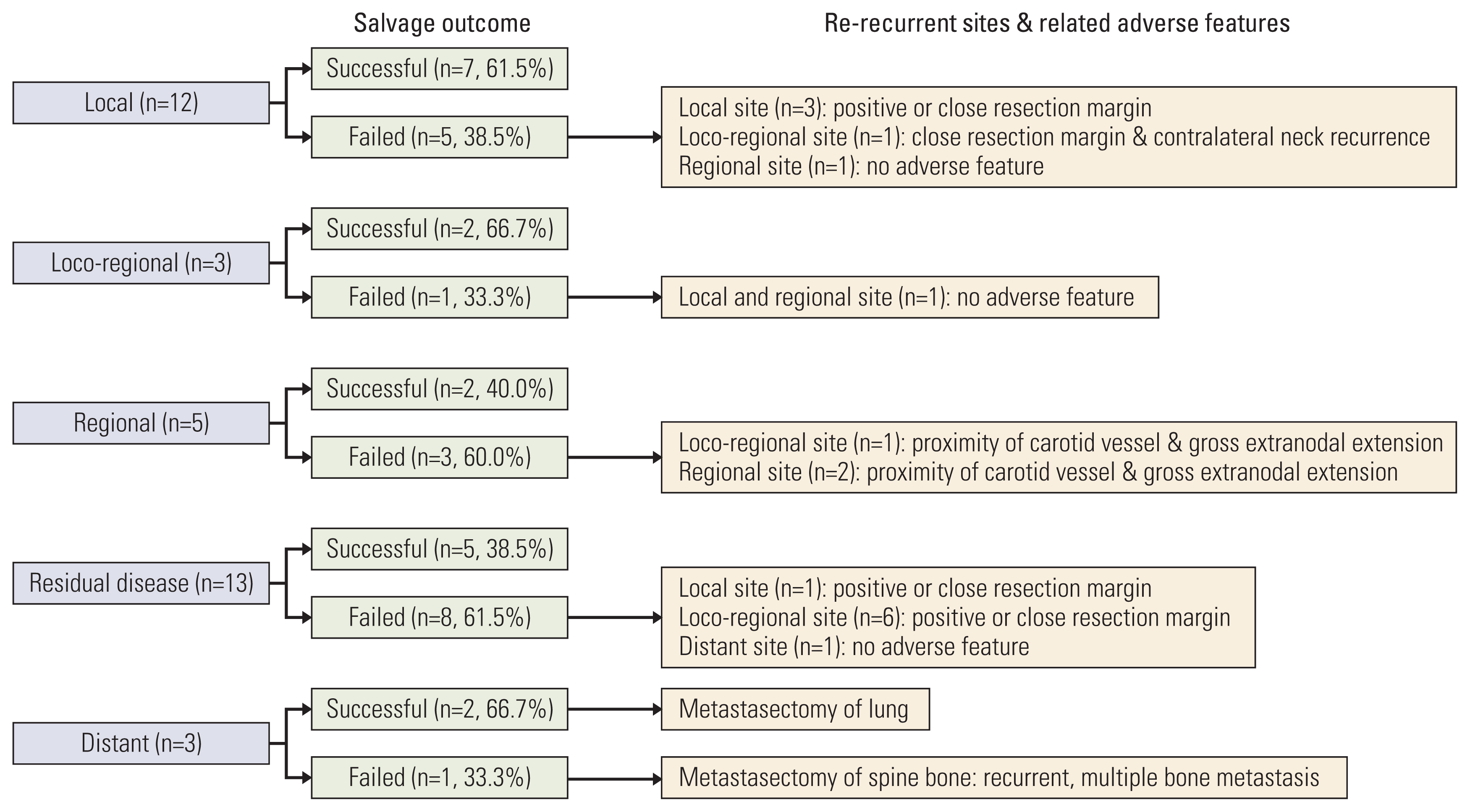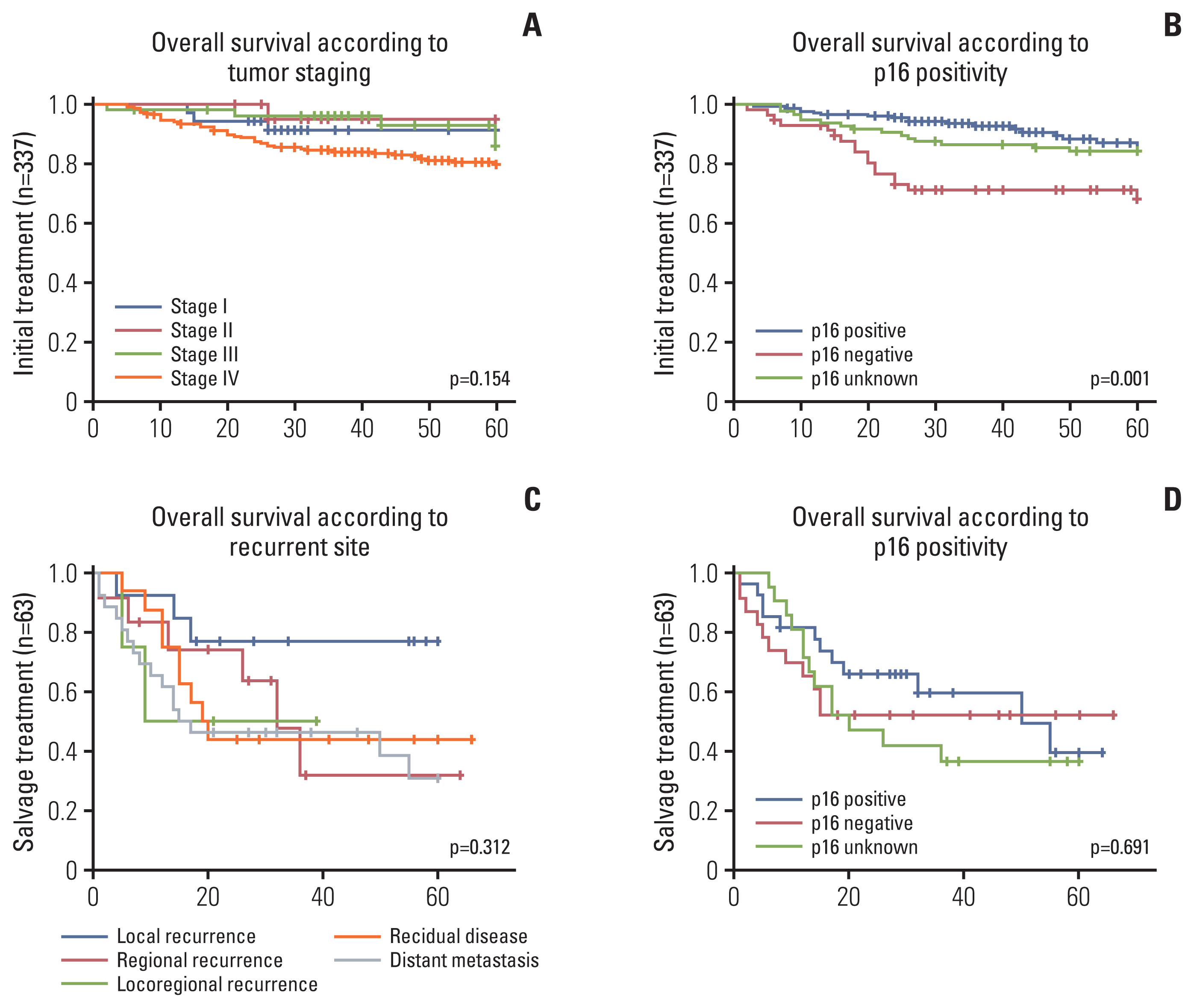Cancer Res Treat.
2023 Oct;55(4):1123-1133. 10.4143/crt.2022.1046.
Outcomes of Salvage Therapy for Oropharyngeal Cancer Recurrence Following Upfront Radiation Therapy and Prognostic Factors
- Affiliations
-
- 1Department of Otorhinolaryngology, Head and Neck Surgery, Samsung Medical Center, Sungkyunkwan University School of Medicine, Seoul, Korea
- 2Department of Radiation Oncology, Samsung Medical Center, Sungkyunkwan University School of Medicine, Seoul, Korea
- KMID: 2547787
- DOI: http://doi.org/10.4143/crt.2022.1046
Abstract
- Purpose
This study aimed to investigate the oncologic outcomes and prognostic factors of salvage treatments in patients with recurrent oropharyngeal squamous cell carcinoma (OPSCC) after radiotherapy (RT)-based treatment.
Materials and Methods
A cancer registry was used to retrieve the records of 337 patients treated with definitive RT or concurrent chemoradiotherapy (CRT) from 2008 to 2018 at a single institution. The poor-responder group (PRG) was defined as patients with residual or recurrent disease after primary treatment, and the oncologic outcomes for each salvage treatment method were analyzed. In addition, prognostic indicators of recurrence-free survival (RFS) and overall survival (OS) were identified in patients who underwent salvage treatment.
Results
After initial (C)RT, the PRG comprised 71 of the 337 patients (21.1%): 18 patients had residual disease, and 53 had recurrence after primary treatment (mean time to recurrence 19.5 months). Of these, 63 patients received salvage treatment (surgery 57.2%, re-(C)RT 23.8%, and chemotherapy 19.0%), and the salvage success rate was 47.6% at the last follow-up. The overall 2-year OS for salvage treatments was 56.4% (60.8% for the salvage surgery group and 46.2% for the salvage re-(C)RT). Salvage surgery patients with negative resection margins had better oncologic outcomes than those with close/positive resection margins. Using multivariate analyses, locoregional recurrence and residual disease after primary surgery were associated with poor outcome after salvage treatment. In Kaplan-Meier analyses, p16 status was significantly associated with OS in the initial treatment setting but not in the salvage setting.
Conclusion
In recurrent OPSCC after RT-based treatment, successful salvage was achieved in 56.4% patients who had undergone salvage surgery and radiation treatment. Salvage treatment methods should be selected carefully, given recurrence site as a prognostic factor for RFS.
Figure
Reference
-
References
1. Chaturvedi AK, Engels EA, Pfeiffer RM, Hernandez BY, Xiao W, Kim E, et al. Human papillomavirus and rising oropharyngeal cancer incidence in the United States. J Clin Oncol. 2011; 29:4294–301.
Article2. Ang KK, Harris J, Wheeler R, Weber R, Rosenthal DI, Nguyen-Tan PF, et al. Human papillomavirus and survival of patients with oropharyngeal cancer. N Engl J Med. 2010; 363:24–35.3. Chen AY, Schrag N, Hao Y, Stewart A, Ward E. Changes in treatment of advanced oropharyngeal cancer, 1985–2001. Laryngoscope. 2007; 117:16–21.4. Cohan DM, Popat S, Kaplan SE, Rigual N, Loree T, Hicks WL Jr. Oropharyngeal cancer: current understanding and management. Curr Opin Otolaryngol Head Neck Surg. 2009; 17:88–94.5. Fakhry C, Westra WH, Li S, Cmelak A, Ridge JA, Pinto H, et al. Improved survival of patients with human papillomavirus-positive head and neck squamous cell carcinoma in a prospective clinical trial. J Natl Cancer Inst. 2008; 100:261–9.6. Roosli C, Studer G, Stoeckli SJ. Salvage treatment for recurrent oropharyngeal squamous cell carcinoma. Head Neck. 2010; 32:989–96.
Article7. Kano S, Homma A, Hayashi R, Kawabata K, Yoshino K, Iwae S, et al. Salvage surgery for recurrent oropharyngeal cancer after chemoradiotherapy. Int J Clin Oncol. 2013; 18:817–23.8. Ang KK, Zhang Q, Rosenthal DI, Nguyen-Tan PF, Sherman EJ, Weber RS, et al. Randomized phase III trial of concurrent accelerated radiation plus cisplatin with or without cetuximab for stage III to IV head and neck carcinoma: RTOG 0522. J Clin Oncol. 2014; 32:2940–50.9. Culie D, Lisan Q, Leroy C, Modesto A, Schiappa R, Chamorey E, et al. Oropharyngeal cancer: first relapse description and prognostic factor of salvage treatment according to p16 status, a GETTEC multicentric study. Eur J Cancer. 2021; 143:168–77.10. Christopherson KM, Moreno AC, Elgohari B, Gross N, Ferrarotto R, Mohamed ASR, et al. Outcomes after salvage for HPV-positive recurrent oropharyngeal cancer treated with primary radiation. Oral Oncol. 2021; 113:105125.11. Heft Neal ME, Brennan J, Brenner JC, Shuman AG, Chinn SB, Stucken CL, et al. Predictors and prevalence of nodal disease in salvage oropharyngectomy. Ann Surg Oncol. 2020; 27:451–7.
Article12. Hay A, Simo R, Hall G, Tharavai S, Oakley R, Fry A, et al. Outcomes of salvage surgery for the oropharynx and larynx: a contemporary experience in a UK Cancer Centre. Eur Arch Otorhinolaryngol. 2019; 276:1153–9.13. Sweeny L, Rosenthal EL, Clemons L, Stevens TM, Cook McIntosh ER, Carroll WR. Outcomes after surgical salvage for recurrent oropharyngeal squamous cell carcinoma. Oral Oncol. 2016; 60:118–24.14. Yoon HG, Ahn YC, Oh D, Noh JM, Park SG, Nam H, et al. Early clinical outcomes of intensity modulated radiation therapy/intensity modulated proton therapy combination in comparison with intensity modulated radiation therapy alone in oropharynx cancer patients. Cancers (Basel). 2021; 13:1549.15. Edge SB, Compton CC. The American Joint Committee on Cancer: the 7th edition of the AJCC cancer staging manual and the future of TNM. Ann Surg Oncol. 2010; 17:1471–4.16. Chung MK, Jeong HS, Park SG, Jang JY, Son YI, Choi JY, et al. Metabolic tumor volume of [18F]-fluorodeoxyglucose positron emission tomography/computed tomography predicts short-term outcome to radiotherapy with or without chemotherapy in pharyngeal cancer. Clin Cancer Res. 2009; 15:5861–8.
Article17. Fakhry C, Zhang Q, Nguyen-Tan PF, Rosenthal D, El-Naggar A, Garden AS, et al. Human papillomavirus and overall survival after progression of oropharyngeal squamous cell carcinoma. J Clin Oncol. 2014; 32:3365–73.18. Guo T, Qualliotine JR, Ha PK, Califano JA, Kim Y, Saunders JR, et al. Surgical salvage improves overall survival for patients with HPV-positive and HPV-negative recurrent locoregional and distant metastatic oropharyngeal cancer. Cancer. 2015; 121:1977–84.19. Patel SN, Cohen MA, Givi B, Dixon BJ, Gilbert RW, Gullane PJ, et al. Salvage surgery for locally recurrent oropharyngeal cancer. Head Neck. 2016; 38(Suppl 1):E658–64.20. Kao SS, Ooi EH. Survival outcomes following salvage surgery for oropharyngeal squamous cell carcinoma: systematic review. J Laryngol Otol. 2018; 132:299–313.21. Zafereo ME, Hanasono MM, Rosenthal DI, Sturgis EM, Lewin JS, Roberts DB, et al. The role of salvage surgery in patients with recurrent squamous cell carcinoma of the oropharynx. Cancer. 2009; 115:5723–33.
Article22. Joseph AW, Guo T, Hur K, Xie Y, Yin L, Califano JA, et al. Disease-free survival after salvage therapy for recurrent oropharyngeal squamous cell carcinoma. Head Neck. 2016; 38(Suppl 1):E1501–9.23. Kostrzewa JP, Lancaster WP, Iseli TA, Desmond RA, Carroll WR, Rosenthal EL. Outcomes of salvage surgery with free flap reconstruction for recurrent oral and oropharyngeal cancer. Laryngoscope. 2010; 120:267–72.24. Boscolo-Rizzo P, Stellin M, Fuson R, Marchiori C, Gava A, Da Mosto MC. Long-term quality of life after treatment for locally advanced oropharyngeal carcinoma: surgery and postoperative radiotherapy versus concurrent chemoradiation. Oral Oncol. 2009; 45:953–7.25. Nichols AC, Theurer J, Prisman E, Read N, Berthelet E, Tran E, et al. Radiotherapy versus transoral robotic surgery and neck dissection for oropharyngeal squamous cell carcinoma (ORATOR): an open-label, phase 2, randomised trial. Lancet Oncol. 2019; 20:1349–59.
- Full Text Links
- Actions
-
Cited
- CITED
-
- Close
- Share
- Similar articles
-
- Salvage radiation therapy for postoperative locoregionally recurrent non-small cell lung cancer: a single-center experience
- Clinical Characteristics of 53 Patients with Recurrent Cervical Cancer Showing Lung Metastasis
- Oncological and Functional Outcomes of Larynx-preserving Surgery for Hypopharyngeal Cancer: A Comparison with Definitive Radiation-based Treatment
- Initial Treatment and Conservation Salvage Surgery of Early Glottic Cancer
- The Results of Postoperative Radiation Therapy in the Rectal Cancer




